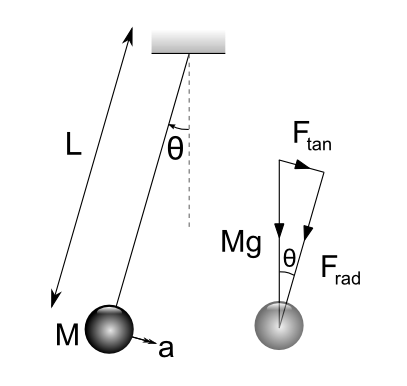Copyright © University of Cambridge. All rights reserved.
'The Not-so-simple Pendulum 1' printed from https://nrich.maths.org/
Show menu
We were sent a wonderfully detailed solution by Ben from Kenny. He has formatted it beautifully, so we are including his pdf directly. It is well worth reading through.
Furthermore, one of our vacation summer students produced the solution given here.
Equation of motion

Considering the forces acting on the pendulum bob acting in the tangential direction
$$F_{tan} = Mg \sin \theta$$
Newton's Second Law:
$$\sum_{i}\mathbf{F_i} = \frac{d}{dt}(m \mathbf{v})$$
Applying tangentially:
$$\Rightarrow M a_{tan} = M g \sin \theta \ \Rightarrow \ a_{tan} = g \sin \theta$$
Changing from translational to angular acceleration $a_{tan} = -\ell \ddot{\theta}$ (negative sign due to opposing directions):
$$\Rightarrow-\ell \ddot{\theta} = g \sin \theta$$
$$\therefore \ddot{\theta} = \frac{-g}{\ell} \sin \theta $$
This is a second-order non-linear differential equation in $\theta$. It cannot be solved easily due to the $\sin \theta$ term. An analytical solution is possible, using what are called elliptical integrals, though it is not reducible to elementary functions.
Comparing with $\ddot{\theta} = -k^2 \sin \theta $ gives
$$k^2 = \frac{g}{\ell} \Rightarrow \ell = \frac{g}{k^2}$$
$$k = 0.1 \Rightarrow k^2 = 0.01 \Rightarrow \ell = 100g = 981\textrm{ m}$$
$$k =1 \Rightarrow k^2 = 1 \Rightarrow \ell = g = 9.81\textrm{ m}$$
$$k =10 \Rightarrow k^2 = 100 \Rightarrow \ell = \frac{g}{100} = 0.0981\textrm{ m}$$
Linearisation using small-angle approximation
The Taylor series expansion of the sine function is:
$$\sin \theta = \theta - \frac{\theta^3}{3!} + \frac{\theta^5}{5!} - \frac{\theta^7}{7!} + O(\theta^9)$$
(where $O(\theta^7)$ indicates terms in $\theta^9$ and above, sometimes called Big-O notation).
For 'small' $\theta$, $O(\theta^3) \ll \theta$ and so $\sin \theta \approx \theta$. 'Small' here has intentionally been left vague as the next part of the question is to consider the validity of this assumption.
To find the range of values for which $\sin \theta$ lies within 1% of $\theta$, find the point at which $\sin \theta$ is exactly $0.99\theta$ (i.e. 1% less).
$\sin \theta = 0.99 \theta$ by numerical methods $\Rightarrow \theta = \pm 0.24532\ \textrm{rad} = \pm 14.1^\circ$